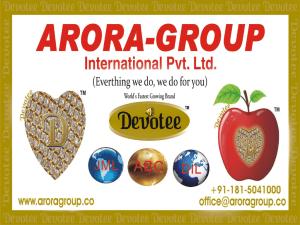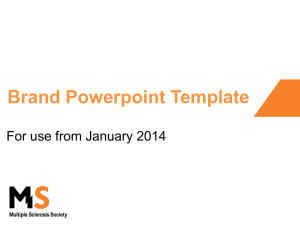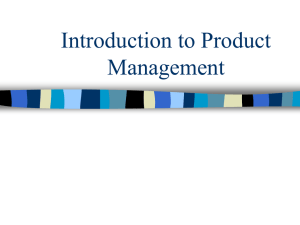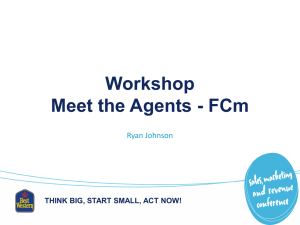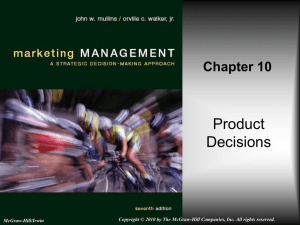Chapter-7 - Surej P John
advertisement
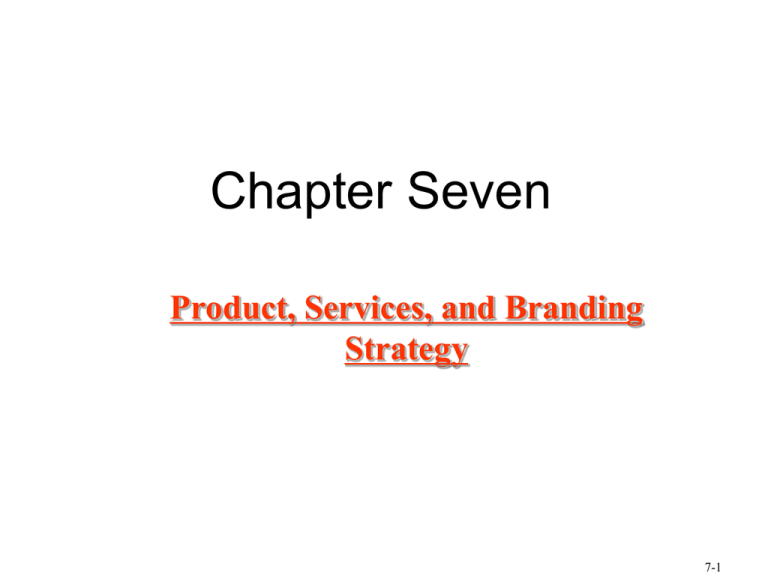
Chapter Seven Product, Services, and Branding Strategy 7-1 What is a Product? • Anything that can be offered to a market for attention, acquisition, use, or consumption and that might satisfy a want or need. – Includes: physical objects, services, events, persons, places, organizations, ideas, or some combination thereof. 7-2 What is a Service? • A form of product that consists of activities, benefits, or satisfactions offered for sale that are essentially intangible and do not result in the ownership of anything. – Examples: banking, hotel, airline, retail, tax preparation, home repairs. 7-3 The Product-Service Continuum Sugar Pure Tangible Good Restaurant University Education Pure Service 7-4 Levels of a Product 7-5 Core Benefit:• The most basic level of a product is the CORE BENEFIT which answers the question “What is the buyer really buying?” • When designing the products, marketers must first define the core, problem solving benefits or services that consumers seek. 7-6 Actual product:• At this second level, product planners must turn the core benefit into actual product. • They need to develop product and service features, design a quality level, a brand name, and packaging. 7-7 Augmented product:• Finally all product manufactures must build an augmented product around the core benefit and actual product by offering additional customer services and benefits. 7-8 Comparison of the Product Concepts of Full Service vs. No Frills or Budget Airlines 7-9 7-10 The Evolving Product Concept in Coffee Marketing 7-11 Products and Service Classifications • Based on the type of consumers that use the products, we can classify the products and services into two groups. • One is Industrial products and the other is Consumer products 7-12 Consumer Products • Products and services bought by final consumers for personal consumption. 7-13 Convenience Products • • • • Purchased frequently and immediately Low priced Mass advertising Many purchase locations – Examples: candy, soda, newspapers 7-14 Shopping Products • • • • Bought less frequently Higher price Fewer purchase locations Comparison shop – Examples: furniture, clothing, cars, appliances 7-15 Specialty Products • • • • • Special purchase efforts High price Unique characteristics Brand identification Few purchase locations – Examples: Ferrari, Rolex Watch 7-16 Unsought Products • New innovations • Products consumers do not want to think about • Require much advertising and personal selling • Examples: life insurance, cemetery plots, blood donation 7-17 Industrial Products • Those purchased for further processing or for use in conducting business. 7-18 Industrial Products Materials and Parts Raw materials, manufactured materials, and parts Capital Items Products that aid in buyer’s production or operations Supplies and Services Operating supplies, repair, and maintenance items 7-19 Other Market Offerings • Organizations: Profit (businesses) and nonprofit (schools and churches). • Persons: Politicians, entertainers, sports figures, doctors, and lawyers. • Places: create, maintain, or change attitudes or behavior toward particular places (e.g., tourism). • Ideas (social marketing): Public health campaigns, environmental campaigns, family planning, or human rights. 7-20 Individual Product Decisions 7-21 Product and Service Attributes Quality Performance and Satisfaction Includes Level & Consistency Features Differentiates a product from the competition; assessed based on value and cost Style & Design Style = Appearance Design = heart of the product 7-22 Branding • A brand is a name, term, sign, symbol, or design, or a combination of these, that identifies the maker or seller of a product or service. 7-23 Branding • Advantages to buyers: – Product identification – Product quality • Advantages to sellers: – Basis for product’s quality story – Provides legal protection – Helps to segment markets 7-24 Packaging • Designing and producing the container or wrapper for a product. • Developing a good package: – Packaging concept – Package elements – Product safety – Environmental concerns 7-25 Labeling • Printed information appearing on or with the package. • Performs several functions: – Identifies product or brand – Describes several things about the product – Promotes the product through attractive graphics 7-26 Product Support Services • Assess the value of current services and obtain ideas for new services. • Assess the cost of providing the services. • Put together a package of services that delights the customers and yields profits for the company. 7-27 Product Line Decisions Product Line Length Number of Items in the Product Line Stretching Filling Lengthen beyond current range. Lengthen within current range Can be: Downward Upward Both Directions 7-28 Product line of Passenger cars of Toyota 7-29 Product Line Stretching 7-30 Two-Way Stretch Marriott added the Renaissance Hotels line to serve the upper end of the market and the TownePlace Suites line to serve the moderate and lower ends. 7-31 Product Mix Decisions Product Mix: all of the product lines and items that a particular seller offers for sale. • Width: the number of different product lines the company carries. • Length: the total number of items the company carries in its product line • Depth: the number of versions offered of each product in the line. • Consistency: how closely related the various lines are. 7-32 Product mix 7-33 Figure 7.6 The Product Mix and Implications for Marketing Strategy 7-34 Brand Development Strategies 7-35 Brand Development • Line Extension: introduction of additional items in a given product category under the same brand name (e.g., new flavors, forms, colors, ingredients, or package sizes). • Brand Extension: using a successful brand name to launch a new or modified product in a new category. 7-36 Brand Development • Multibranding: offers a way to establish different features and appeal to different buying motives. • New Brands: developed based on belief that the power of its existing brand is waning and a new brand name is needed. Also used for products in new product category. 7-37




